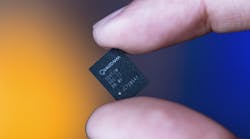Qualcomm has been cleared by European regulators to complete its acquisition of NXP Semiconductors. The antitrust approval puts Qualcomm another step closer to officially closing the deal, which has been complicated by begrudged investors and a controversial battle for control of Qualcomm’s board.
On Thursday, Qualcomm said that it had reached a compromise with regulators in Europe not to increase prices for NXP’s near field communication chips, which can be embedded in smartphones to enable touchless payments in stores. The company also agreed not to acquire certain patents from NXP, based in Eindhoven, the Netherlands.
Qualcomm has been scrutinized and penalized for unfair patent licensing practices around the world, including in the U.S., where it was separately granted approval for the deal last year. The company also said Thursday that it had been granted approval in South Korea for the deal, which would turn it into the world’s biggest supplier of automotive chips.
The European Commission, which sets competition policy within the 28-country bloc, said that it worried Qualcomm would bundle its standard 3G and 4G patents with NXP’s near field communications technology for smartphones. That would allow it to charge higher prices for NXP's technology, hurting potential customers.
The regulator also said that the combined company would have had “ability and incentive to degrade the interoperability” of its chips with rival silicon. That way, Qualcomm could sway customers in the smartphone market like Apple and Samsung to prefer its products while unfairly marginalizing rivals, the regulator said.
In response, Qualcomm said that it would exclude standard-essential patents for near-field communications from the deal, handing them over to a third party bound to license them royalty-free for three years. It would also relinquish its right to certain non-standard patents and license the patents that it holds onto without charging royalties.
In addition, Qualcomm vowed to provide the same level of interoperability between its chipsets and corresponding products of other companies for eight years. The company also agreed not to raise prices for NXP’s MiFare technology – which many public transportation systems across Europe use to collect fares electronically – for eight years.
“With this decision, we ensure that Qualcomm’s takeover of NXP will not prevent consumers from continuing to enjoy the benefits of these innovative technologies at competitive prices,” Margrethe Vestager, Europe’s competition commissioner, said in a statement. The commission said that the modified deal no longer raised competition concerns.
Passing regulators is a rare victory for Qualcomm, which has been buffeted by antitrust fines around the globe and a bitter legal battle with Apple over its licensing fees. It is also trying to withstand a hostile takeover attempt by rival Broadcom. Last year, the company rejected Broadcom’s $105 billion bid as well as the 11 directors that Broadcom nominated to take over Qualcomm's board.
The company’s message to investors to recent weeks has been that Qualcomm can thrive without Broadcom. Qualcomm has been trumpeting the potential windfall from 5G wireless technology and the company's growth prospects in hot new markets like connected cars and the Internet of Things.
Steve Mollenkopf, chief executive of Qualcomm, said in a recent investor presentation that the firm would deliver between $6.75 and $7.50 per share in profit next year. He said that the NXP acquisition would account for around a fifth of these profits. The rest of the profit would stem from the market for 5G wireless technology and a $1 billion cost-cutting plan.
But it still has to charm NXP shareholders, which have largely refused to accept Qualcomm’s offer of around $47 billion in cash and debt. It’s not clear when the company may complete the deal, which was originally supposed to close by last month. Last week, Qualcomm once again extended the cash tender offer for NXP's outstanding shares, underlining its troubles.
The New York asset management fund Ramius recently complained that Qualcomm had severely undervalued its one-percent stake in NXP. That follows the protests of NXP’s largest investor Elliott Management, which has been vociferously opposed to Qualcomm’s offer. The $110-per share offer has capped NXP’s stock price, Elliott says.
On the regulatory front, Qualcomm has been granted approval in almost every country. It is still waiting to hear from China, where it has butted heads with antitrust officials before. In 2015, regulators there fined Qualcomm almost a billion dollars for unfair licensing practices, forcing it to renegotiate contracts with customers in one of its most important markets.
But in a statement, Mollenkopf said that “we are optimistic that China will expeditiously grant its clearance.” He added that “NXP is complementary to Qualcomm’s global portfolio, providing tremendous scale in automotive, IoT, security and networking and will greatly accelerate our ability to execute and create value in new and adjacent opportunities.”
